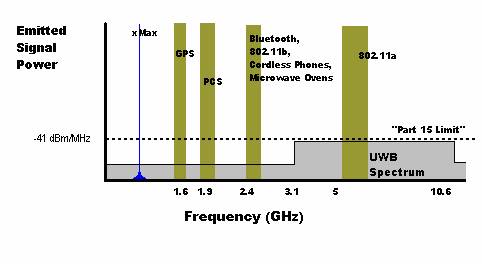In its March 10, 2005, order (FCC Docket No. 05-57), the FCC recognized technical measures that cognitive or software-defined radios can employ that will allow reliable secondary use of radio frequency (RF) spectrum while maintaining that spectrum’s availability as well as its rapid reversion to the licensee when needed. However, the Commission saw no need to mandate a particular technical model for this kind of interruptible spectrum leasing. “Ultimately,” the Commission concluded, “a licensee must itself be satisfied that the technical mechanism being implemented under a lease does in fact provide it with the ability in real time to reclaim use of its spectrum when necessary.”
This kind of leeway opens the door for developers to push the envelope on spectrum multipurposing or re-use techniques, particularly those employing dynamic frequency-hopping over a wide range. We believe that a forthcoming modulation technique known as xMax™ offers the capability to go beyond interruptible usage, achieving simultaneous non-interfering use.
Spectrum Multipurposing
Exploiting unused regions of dedicated spectrum – the conceptual core of spectrum re-use – is a fairly significant departure from the single-use allocation scheme the FCC employs today. The 05-57 Order, however, embraces technologies that enable multiple uses … and users.
The low-power transmission profile of ultra-wideband (UWB) takes us in that direction. However, as Figure 1 illustrates, UWB’s sideband emissions have relegated its use to higher frequency spectrum in order to avoid harmful interference in other allocated channels. These higher frequency signals – ranging between 3.1 GHz and 10 GHz – possess limited propagation characteristics, making them less than ideal for large-scale networking.
The xMax Solution
To meet this challenge, xG Technology, LLC is developing an RF modulation technique it calls xMax – a hybrid technology combining aspects of narrowband carrier systems and low-powered wideband pulse position modulation (PPM).
Existing wireless technology attempts to move as much power as possible into the sidebands (where the information resides) and away from the carrier wave. xMax, in contrast, places nearly all (over 99 percent) of the power in the carrier, keeping sideband energy emissions negligible. xMax is characterized by a spectrum utilization profile where adjacent channel spillover is so far below detectable levels it has no effect on neighboring users (see Figure 1). The carrier is used to correlate with the information to enable reception.
The Wavelet Pass Filter is the key to xMax. This device, which provides significant signal processing gain, allows the receiver to recover the weak information-bearing signal found amidst the narrowband interference and noise from legacy and neighboring users in the adjacent sidebands. Using the carrier to synchronize transmitter and receiver simplifies recovery of the relatively weak information pulse, requiring far less power than UWB, which builds the timing function into the information borne by the signal, increasing the noise floor to levels approaching the FCC’s “Part 15” limits.

Figure 1: xMAX Spectrum Utilization Profile
This results in a power spectral density substantially below that of UWB. The carrier itself occupies little bandwidth while the information-bearing signal is spread over a wide sideband (1 to 100 MHz depending on throughput needs) that is well below the noise floor. Because the spectral power is so low in the adjacent bands legacy users experience no interference and are free to continue normal operation, thereby allowing for spectrum re-use.
Applications
We are optimistic about xMax’ potential in the fixed wireless space. Using a 6 KHz voice channel for the carrier wave, for instance, a provider could deliver data rates on the order of megabits per second. And by using lower frequency spectrum (the field-tested xMax prototype uses a narrowband VHF paging channel) xMax can achieve greater signal distance. This translates into fewer access points or towers, lower network costs and increased margins.
Conclusion
In releasing the FCC’s 05-57 Order, Commissioner Jonathan Adelstein remarked, “Spectrum policy is a two-sided coin: a framework for innovation on one side, with spectrum facilitation on the other.” We couldn’t agree more. The Commission has made a move toward facilitating spectrum availability; now the coin is flipped to innovative engineers keen on delivering a solution. The xMax modulation scheme is an example of what the industry can do when given the chance to let technology – not strict regulation – set the boundaries.
|
About the Authors
Joseph Bobier, original inventor of the single cycle modulation and demodulation concept, is president of operations for xG Technology, LLC. Mr. Bobier formally trained in electronics and communications technology in the United States Navy. Since then he has received several patents in the fields of renewable energy, wireless networking and radio modulation technologies. Currently, he heads the Fort Lauderdale, Fla., technical offices for xG Technology.
Stuart Schwartz has been teaching and conducting research in communications at Princeton for almost 40 years. He was chair of the department during the period 1985-1994, and served as Associate Dean for the School of Engineering during the period July 1977-June 1980. He has also held visiting academic appointments at Bell Laboratories, Dartmouth, University of California, Berkeley, The Technion, Israel, and the Image Sciences Laboratory, ETH, Zurich. He has served as an expert witness and has also advised companies in the area of wireless technologies. His principal research interests are in signal processing for communications and image processing.
|
|